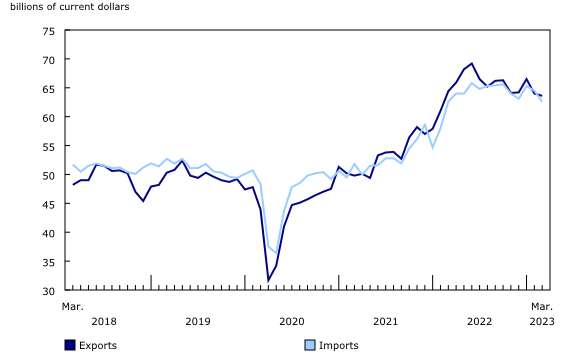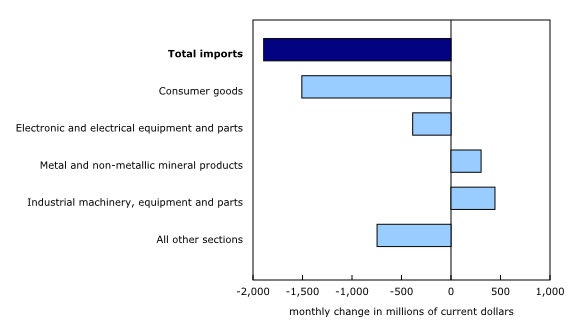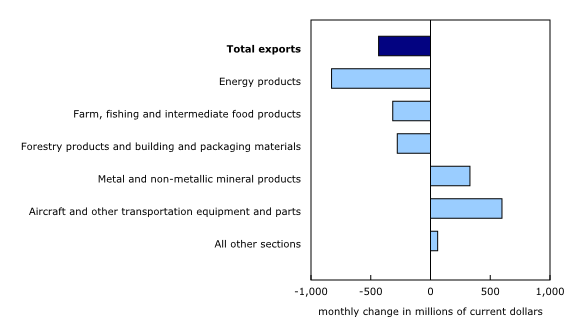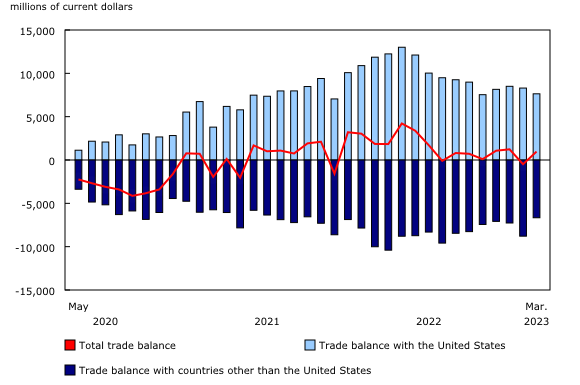Canadian international merchandise trade, March 2023
Released: 2023-05-04
In March, Canada's merchandise imports decreased 2.9%, while exports were down 0.7%. As a result, Canada's merchandise trade balance with the world moved from a revised $487 million deficit in February to a $972 million surplus in March. As was the case in recent months, the March trade balance was close to the typical bounds for revisions, and only represented 0.8% of total exports and imports combined.
Consult the "International trade monthly interactive dashboard" to explore the most recent results of Canada's international trade in an interactive format.
Following a sharp increase in February, imports of pharmaceutical products decrease in March
Total imports decreased 2.9% in March to $62.6 billion, the lowest level observed since March 2022. In real (or volume) terms, imports fell 5.3% in March 2023.
Imports of consumer goods (-11.0%) decreased the most in March, mainly because of lower imports of pharmaceutical products (-31.8%). In February, large quantities of drugs unrelated to COVID-19 were imported, and these shipments did not repeat in March, causing a sharp drop for the month. Excluding pharmaceutical products, imports of consumer goods were down 5.1%, with clothing, footwear and accessories (-11.9%) and miscellaneous goods and supplies (-5.7%) posting the largest declines.
Imports of electronic and electrical equipment and parts (-5.2%) also contributed to the decrease in March. Imports of communication and audio and video equipment (-12.6%), which is largely composed of cellphones, posted the largest decline. This decrease follows two months of high levels that coincided with the release of new cellphone models, which occurred earlier than usual this year. Additionally, following two consecutive monthly gains, imports of computers and computer peripherals (-10.4%) decreased in March.
Ninth consecutive monthly decrease for exports of energy products
Total exports decreased 0.7% in March to $63.6 billion, the lowest level since February 2022. In real (or volume) terms, exports edged up 0.1% in March 2023.
Exports of energy products decreased 5.9% in March, mainly because of lower exports of crude oil (-8.6%). While this was mostly the result of lower prices, crude oil export volumes also decreased in March.
Other notable March declines were observed in the farm, fishing and intermediate food products (-5.3%) and the forestry products and building and packaging materials (-6.4%) product sections.
Exports of aircraft and other transportation equipment and parts rose 30.8% in March, partially offsetting the overall decrease. Exports of aircraft more than doubled in March, in large part because of the increase in exports of business jets to the United States.
Exports and imports edge down in the first quarter of 2023
Total exports were down 0.3% in the first quarter of 2023, mainly because of lower prices. Meanwhile, quarterly imports edged down 0.2%. However, in real terms (calculated using chained 2012 dollars), quarterly exports increased 3.5%, while imports decreased 0.4%.
Revisions to February merchandise export and import data
Imports in February, reported at $64.6 billion in the previous release, were revised to $64.5 billion in the current reference month. Exports in February, reported at $65.0 billion in the previous release, were revised to $64.0 billion, mainly because estimates for natural gas exports were replaced with actual data. As a result of these revisions, the trade balance changed from a surplus to a deficit position in February.
Note to readers
Merchandise trade is one component of Canada's international balance of payments (BOP), which also includes trade in services, investment income, current transfers, and capital and financial flows.
International trade data by commodity are available on both a BOP and a customs basis. International trade data by country are available on a customs basis for all countries and on a BOP basis for Canada's 27 principal trading partners (PTPs). The list of PTPs is based on their annual share of total merchandise trade—imports and exports—with Canada in 2012. BOP data are derived from customs data by adjusting for factors such as valuation, coverage, timing, and residency. These adjustments are made to conform to the concepts and definitions of the Canadian System of National Accounts.
For a conceptual analysis of BOP-based data versus customs-based data, see "Balance of Payments trade in goods at Statistics Canada: Expanding geographic detail to 27 principal trading partners."
For more information on these and other macroeconomic concepts, see the Methodological Guide: Canadian System of Macroeconomic Accounts (13-607-X) and the User Guide: Canadian System of Macroeconomic Accounts (13-606-G).
The data in this release are on a BOP basis and are seasonally adjusted. Unless otherwise stated, values are expressed in nominal terms, or current dollars. References to prices are based on aggregate Paasche (current-weighted) price indexes (2012=100). Movements within aggregate Paasche prices can be influenced by changes in the share of values traded for specific goods, with sudden shifts in trading patterns—as observed with the COVID-19 pandemic—sometimes resulting in large movements in Paasche price indexes. Volumes, or constant dollars, are calculated using the Laspeyres formula (2012=100), unless otherwise stated.
For information on seasonal adjustment, see Seasonally adjusted data – Frequently asked questions.
Revisions
In general, merchandise trade data are revised on an ongoing basis for each month of the current year. Current-year revisions are reflected in both the customs-based and the BOP-based data.
The previous year's customs-based data are revised with the release of data for the January and February reference months, and thereafter on a quarterly basis. The previous two years of customs-based data are revised annually, and revisions are released in February with the December reference month.
The previous year's BOP-based data are revised with the release of data for the January, February, March and April reference months. To remain consistent with the Canadian System of Macroeconomic Accounts, revisions to BOP-based data for previous years are released annually in December with the October reference month.
Factors influencing revisions include the late receipt of import and export documentation, incorrect information on customs forms, the replacement of estimates produced for the energy section with actual figures, changes in merchandise classification based on more current information, and changes to seasonal adjustment factors. The seasonal adjustment parameters are reviewed and updated annually and applied with the October reference month release.
For information on data revisions for exports of energy products, see Methodology for Exports of Energy Products within the International Merchandise Trade Program.
Revised data are available in the appropriate tables.
Real-time data table
The real-time data table 12-10-0120-01 will be updated on May 15.
Next release
Data on Canadian international merchandise trade for April will be released on June 7.
Products
The product "International trade monthly interactive dashboard" (71-607-X) is now available. This new interactive dashboard is a comprehensive analytical tool that presents monthly changes in Canada's international merchandise trade data on a balance-of-payments basis, fully supporting the information presented every month in the Daily release.
The product "The International Trade Explorer" (71-607-X) is now available online.
The Canadian International Merchandise Trade online database is no longer available. It has been replaced by the Canadian International Merchandise Trade Web Application (71-607-X), a modern tool that provides trade data users with a number of enhancements.
The updated "Canada and the World Statistics Hub" (13-609-X) is now available online. This product illustrates the nature and extent of Canada's economic and financial relationship with the world using interactive charts and tables. It provides easy access to information on trade, investment, employment and travel between Canada and a number of countries, including the United States, the United Kingdom, Mexico, China, Japan, Belgium, Italy, the Netherlands and Spain.
Contact information
For more information, or to enquire about the concepts, methods or data quality of this release, contact us (toll-free 1-800-263-1136; 514-283-8300; infostats@statcan.gc.ca) or Media Relations (statcan.mediahotline-ligneinfomedias.statcan@statcan.gc.ca).
- Date modified:







